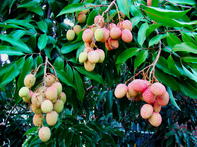Litchis are not indigenous to South Africa; litchi cultivars were imported from the state of Florida in the United of America as well as from India, Taiwan and China.

Types of Litchis
Litchis are divided into three groups - Mauritius, Chinese and Madras - with the Chinese group of cultivar mostly farmed internationally.
In South Africa, litchi production is dominated by the Mauritius type of litchis. The Mauritius group is usually planted locally as well as abroad and produces satisfactory yields and fruit of good quality. An example is HLH Mauritius.
The Chinese group of litchi cultivars produce fruit of excellent quality but very poor yields. The Chinese type of litchis often has chicken-tongue seeds. Cultivars include Haak Yip and Three Months Red.
The Madras litchi group bears beautiful red fruit, but fruit quality is poor. McLean Red is a Madras litchi.
Litchi Cultivars in South Africa
Although many cultivars have been tested in South Africa, commercial litchi plantings are based on two cultivars, HLH Mauritius (also known as Tai So) and McLean's Red.
The earliest litchi, Third Month Red can be picked from October. It has large heart-shaped fruit with tough deep-red skin when ripe. The seed is large and the flesh around the seed turns brown as the fruit ripens. The tree grows upright but is impossible to graft due to its dry wood.
HLH Mauritius was introduced into South Africa in 1875 and is a mid-season cultivar with medium-large fruit with crisp sweet flesh and red skin when ripe. The vigorously growing tree tends to have a spreading crown, susceptible to wind damage.
McLean’s Red is the second most grown cultivar in South Africa, picked in mid to late season. It has a poor flesh-to-seed ratio due to its large seed but has soft sweet flesh. The fruit is red with a pointy tip. Trees exhibit vigorous spreading growth.
Wai Chee is the main cultivar grown in China and was only introduced to South Africa in the 1990s. It is a medium-sized a late-season litchi with a yellowish-red skin, fragrant flesh and a small seed. The tree is compact and dense.
New Cultivars
Research into new litchi cultivars looks at yield potential and fruit quality characteristics, such as small seeds. Research also focuses on creating high-yielding early and late cultivars, specifically for certain early and late-producing regions in South Africa.
This leads to increasing the availability of South African litchis in times when there is a limited production from northern hemisphere producers, means a higher price and an increased demand for South African litchis for export, particularly to China.
This also means having a peak production of litchis around February to coincide with China’s New Year celebrations. The Chinese market particularly likes large fruit with good colour and small seeds.
By Marinda Louw